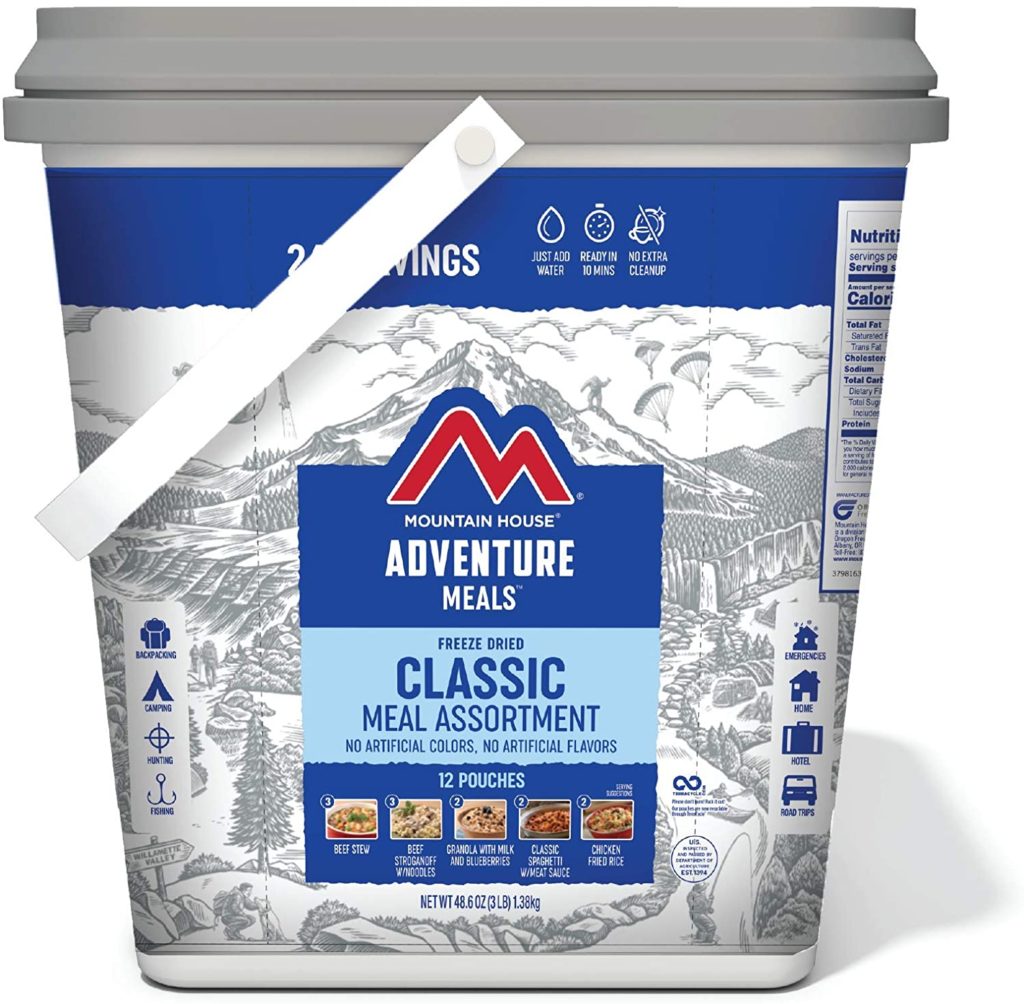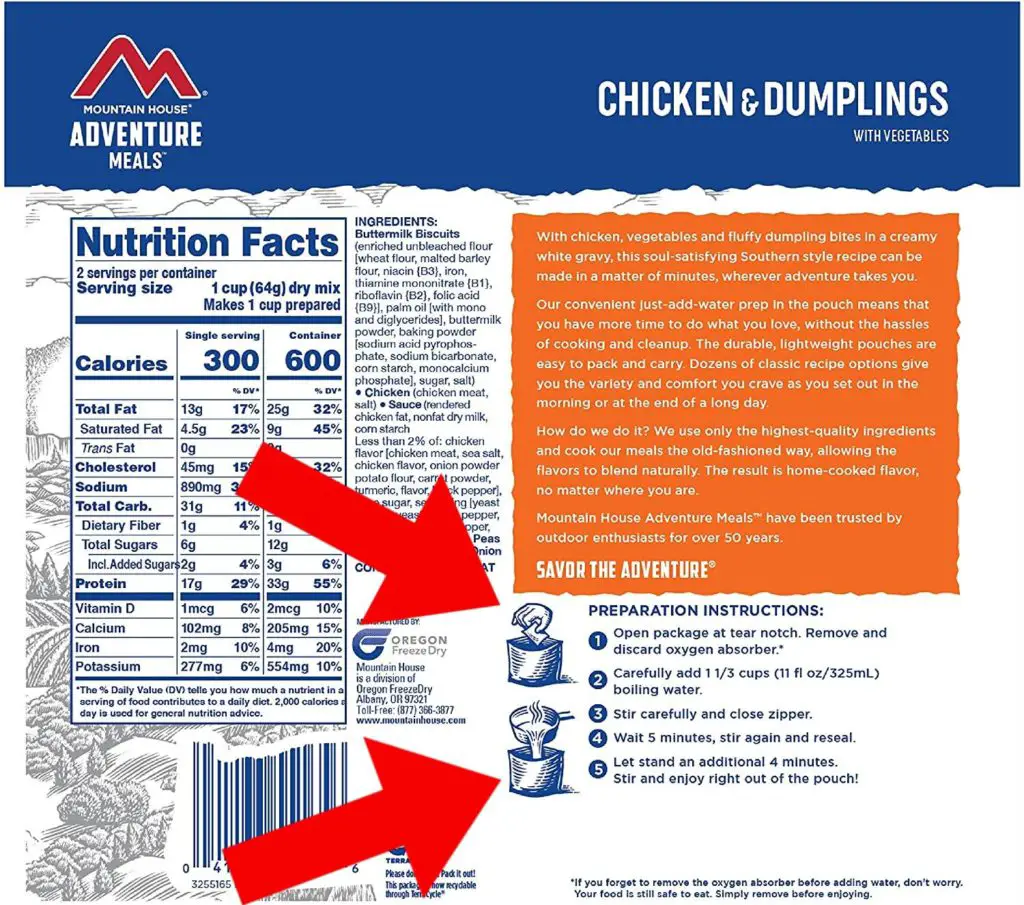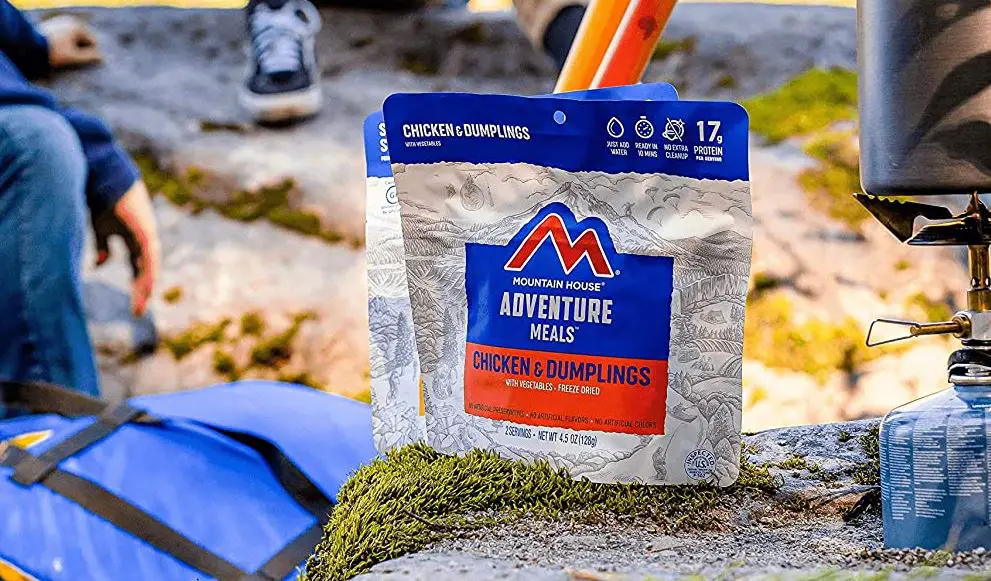Excited about the hike that’s coming up in a week? Great, but one of the most important factors you need to consider while packing your outdoor gear is the ration of food you will be taking along with you. How much food should you carry? How much is too little and how much is too much? We answer all these questions and more, in this article.
Let’s begin with how to pack freeze-dried food so that they don’t spoil.
Table of Contents
How to Pack Mountain House Meals
Mountain House meals are available as pouches, cans, buckets, emergency supply kits and military rations. The meals that are usually purchased for hiking contain a minimum of two servings each. Pouches are flat packs that can be stacked one on top of the other. Buckets contain a minimum of 14 freeze-dried packs and are more convenient to carry just as they are because then, you don’t have to pack extra food in your backpack.
Cans carry a minimum of 7 servings and there are 22 serving packs available also. I don’t recommend carrying cans for a hike because it adds to your backpack weight. Besides, the contents of a can will need to be finished on opening as it cannot be stored for longer. The ‘Just in Case’ Emergency food kits however, are perfect for solo hikers as all 3 meals of the day will be taken care of even in a basic kit like the 4-day supply.
Can Mountain House Meals Be Repackaged
Yes, the contents of all Mountain House meals can be repackaged, if done carefully.
On one hand, Mountain House takes a lot of care in packing their food in such a way that the contents stay fresh without spoiling in vacuum sealed bags. However, if your backpack is already stuffed with other essential items, then it is possible you may find that the sharp edges of the pack may pose a slight problem and could puncture other packed items.
So, here are two alternatives to carrying lots of sharp-edged Mountain House freeze dried meals in your backpack:
- If you’re carrying a separate cookpot, then you can divide the contents of the pack into small sandwich bags or zip lock bags which are easier to pack in one backpack. However, both do not keep out oxygen, so there is a chance that the dried food may be a bit moist and may not taste as fresh as expected. Or, invest in a vacuum pack sealer and you can be assured of fresh food always. When it’s time to eat, simply use the cookpot to boil water and throw the contents of the smaller pouches into it. Do not ever pour hot water directly into the sandwich bag as the plastic is simply too thin to contain the heat.
- If you don’t have a separate cookpot and yet want to divide the meals into pouches for easier carrying, then I recommend using zip lock freezer bags or microwave bags. This way, you can boil water separately, pour it directly into these bags and eat it straightaway. Or, you could still keep one of the thicker pouches that the Mountain House freeze dried contents come in, and use that for rehydrating the food.
How to Divide Up Larger Meals for Packing

Hiking enthusiasts often say that opening a sealed Mountain House pack and then repackaging the contents does dampen the flavor and natural aroma, but if you’re sure that lugging around extra weight in food on the hike is not on the agenda, then here are a few tips that could help in redistributing the weight-
- Some of the biggest servings that Mountain House offers are the can freeze dried meal options which contain up to 22 servings. If you’re travelling solo, I recommend dividing the entire contents into ten smaller portions (a little bit more than 2 servings per portion) and then re-packing them into individual small zip lock bags. Double freezer bags work just as well. If you have a vacuum sealer that sucks out any remaining oxygen, you’re guaranteed food that will taste fresher.
- If you are hiking with friends, then carrying the smaller zip lock bags becomes much easier and the weight of the food will be distributed more evenly. Honestly, the right serving size for eating varies from one individual to another and while Mountain House offers a minimum of two servings per pack, lots of adults happily consume two servings after a long hot day outdoors. To put it simply, the smaller the serving size that you eat, the more food you will have for your trip.
- If you plan on carrying seasonings like salt, sugar or sauces along, then I recommend packing them into smaller zip lock pouches and then placing them all together in a bigger plastic sealed container.
How To Cook Mountain House Meals
Every Mountain House freeze-dried meal pack comes with a set of instructions on how to cook it right but it does take a few attempts to master how to make an outstanding meal without turning it to mush.

Even if you have repacked the contents into smaller zip lock bags, I do not recommend cooking directly in them as they don’t hold heat as well as the metallic bag that comes with every Mountain House meal does. Pouring hot water into a plastic sandwich bag is also a no-no, as the plastic could melt and you could end up with little bits of hard to detect plastic in your food.
Let’s assume that you are cooking the entire two servings in the pack. So, the best way to begin is by boiling two cups of water (since some of the water will get evaporated anyways) and as the water boils, open the Mountain House freeze-dried meal pack carefully. Ensure that the re-sealer does not damaged because that is going to help the food inside get cooked evenly. Before pouring the hot water directly inside the pack, remove the oxygen absorber first. I recommend stirring the contents of the pack as you pour the water so that everything gets rehydrated equally. Close the pouch that has the zipper and just let the pack stay that way for a minimum of 10- 12 minutes. Before re-opening the pack, shake the bag gently and then open the pack to eat.
If you prefer to use a pot instead of the bag for cooking the food, then mix the food and water together and then boil it together. Boiling the water first and then adding the contents of the pack, could turn the food to mush. Make sure that the pot stays covered so that the food is rehydrated thoroughly and keep the flame low since the food is already cooked. I suggest checking the food every 4 minutes to make sure that it doesn’t dry up too fast or become mushy.
How Long do Mountain House Meals Last
Mountain House really does have an amazing array of freeze-dried meals. However, the brand offers a taste guarantee of 30 years on the Adventure Meal packs, Pro-Pack pouches as well as for the Just In Case cans and multi-day kits.
Interestingly, the shelf-life of the products was raised only in 2016 and the brand says that the reason why they can confidently say that a minimum of 30 years of unspoilt taste is what you get on each product (except for the freeze-dried ice-cream) is because their tests have shown that the shelf-life of the products is more than 30 years. Tests have been conducted by their team on products that were stored in different climatic conditions and settings to check if the food really could be consumed after the 30-year guarantee was over. And, the brand says yes, their products have passed all tests.
Of course, Mountain House also suggests that the food be stored in a dry environment without exposure to sunlight or extreme temperatures so that the chances of damaging the package externally and of the freeze- dried contents internally getting spoilt are significantly reduced.
How Much Do Mountain House Meals Weigh?
Since the food is freeze-dried, it means that almost 80% of the water content in the food has been removed. That by itself reduces the weight of the contents.
Mountain House Adventure meal pouches usually weigh anywhere between 3.7-4.5 ounces (that would be 105 grams- 150 grams) and all packs have a minimum of two servings each.

The cans weigh anywhere between 15 ounces – 28.2 ounces (that would be 424 grams to 800 grams) as they contain a minimum of 7 servings.
The Adventure Meal Buckets weigh between 41.8 ounces to 63.1 ounces (1.2 kg to 1.8 kgs) as they contain a minimum of 22 servings per bucket.
Can you reuse Mountain House Bags?
Yes, Mountain House bags can be reused but cleaning them thoroughly isn’t an easy task. For packs that contain sauces like lasagna or pasta, getting the last bits out can be really tedious.
Plus, the aluminum foil inside the pack which keeps the food hot can tear easily with rigorous cleaning and scrubbing. So, unless you’re willing to undertake all the extra cleaning just to reuse the bag, I personally do not recommend reusing Mountain House bags.
So, how does one dispose of such bags responsibly? Any good hiker knows that garbage accumulation is an important concern that needs to be addressed.
The good news is that the brand itself has partnered with TerraCycle which takes used Mountain House pouches, melts the plastic and then reuses this plastic to make other products. This is without doubt, the best way to dispose of any Mountain House pouches responsibly.

